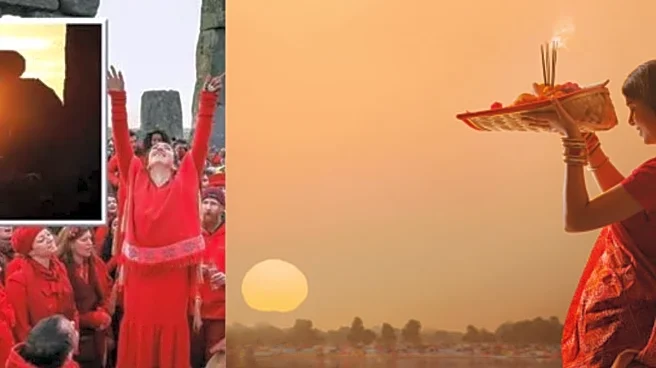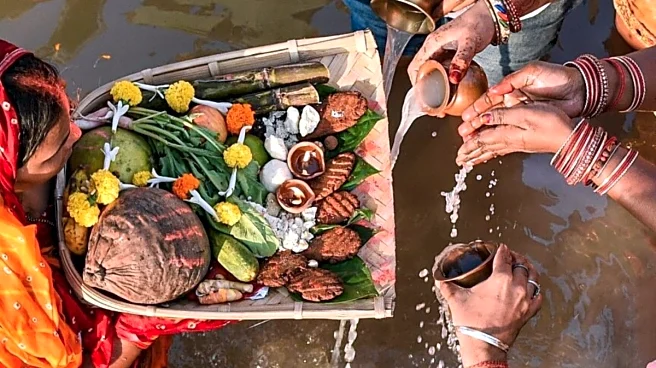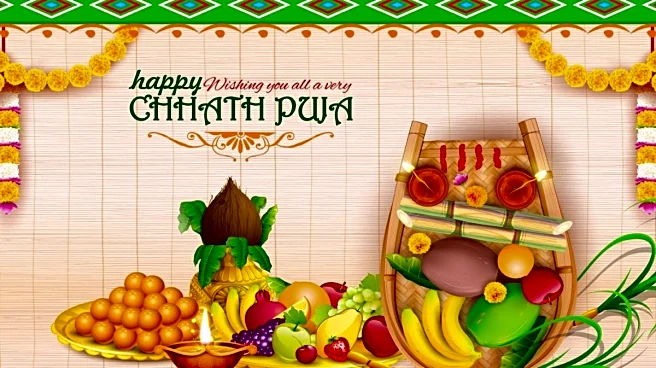As the 36-hour waterless fasting for Chhath began on Saturday with the ‘Nahay Khay’ ritual, with women offering fruits and flowers to Surya aka Sun God. Another celebration, Yule awaits but far across
the world, in frost-covered European towns, when villagers will gather around fires, hang evergreen wreaths, and sing songs that mark the return of the Sun during the darkest nights of the year.
Two celebrations, separated by continents and centuries, yet their rhythm feels alike, as if one is a doppelganger of the other. Both Chhath Puja and Yule, honour the sun, mark the changing seasons, and bind communities through ritual.
Chhath Puja is a centuries-old celebration devoted to Surya, the sun deity. Observed mainly in Bihar, Uttar Pradesh, and Nepal, it emphasises ritual purity, fasting, and collective devotion. For four days, devotees maintain strict abstinence, observe meticulous hygiene, and perform ceremonies at sunrise and sunset. The festival is a meditation on life, endurance, and gratitude, connecting participants deeply with the rhythms of nature.
Yule, by contrast, originates in pre-Christian Europe as a winter solstice festival. It celebrated the rebirth of the sun and the promise of longer days ahead. Communities gathered around fires, feasted, sang hymns, and adorned their homes with evergreens. Later, many Yule traditions were absorbed into Christmas, but the essence, a communal acknowledgement of celestial cycles and seasonal change remained.
Both festivals, though separated by continents, emerge from the same human impulse: to mark seasonal transitions, express gratitude for light, and celebrate renewal.
What Is The Significance of Chhath Puja in India?
Chhath Puja, celebrated predominantly in Bihar, Uttar Pradesh, and parts of Nepal, is a festival of devotion and austerity. For four days, devotees observe strict fasting, maintain ritual purity, and perform elaborate ceremonies at sunrise and sunset, standing knee-deep in river waters, offering prayers to Surya, the sun deity. Folk songs echo across the waters, their melodies steeped in centuries of oral tradition.
The act of offering prasad fruits, the traditional “thekua” biscuits, and other symbolic items is an expression of gratitude for the sun’s life-giving energy. It is a festival that demands discipline, but also patience, resilience, and an intimate connection with nature.
Every gesture from kneeling in water to presenting offerings is a meditation on resilience, devotion, and the life-giving energy of the sun. It is a festival that requires patience, but in return, it offers profound connection to community, to nature, and to something greater than oneself.
What Is The Significance of Yule Celebrations In Europe?
Across Europe, Yule traces its origins to pre-Christian winter solstice celebrations. Long before Christmas, Yule marked the winter solstice, Yule marked the turning of the year, the rebirth of the sun, and the hope for longer days ahead. Communities gathered to light bonfires, decorate with evergreens, and sing carols. The evergreen itself, a symbol of life enduring the harshest winters, mirrored humanity’s need to assert vitality against the dark. Offerings were made to spirits, and feasts celebrated both survival and the cyclical promise of the sun’s return.
Feasts celebrated both survival and continuity, while rituals honoured ancestors and the unseen forces of nature. The evergreen, resilient through harsh winters, symbolised life enduring against darkness.
These practices reveal the same human instinct evident in Chhath Puja, a desire to recognise celestial rhythms, to celebrate continuity, and to ritualise gratitude for forces beyond human control.
What Is Common Between Chhath Puja And Yule?
The parallels are subtle but undeniable, what links Chhath Puja and Yule is not merely a seasonal coincidence but a shared human impulse to anchor existence within celestial rhythms.
Both festivals celebrate light in moments of darkness, whether the literal darkness of winter nights in Europe or the metaphorical trials of fasting and discipline in India.
Both festivals rely on communal participation, connecting individuals through ritual, song, and shared experience. In standing by rivers or fires, humans enact a dialogue with forces far beyond themselves, negotiating gratitude, hope, and continuity.
Both Chhath Puja and Yule occur during a transitional period winter solstice in Europe, late autumn to early winter in India, when human attention turns to light and survival.
Both involve communal participation, songs, offerings, and reverence for forces larger than the individual.
At their core, they are expressions of hope: hope for renewal, for life, and for continuity in the face of darkness. They demonstrate that despite geography and culture, humans have consistently sought meaning in the cyclical patterns of nature.
Even today, Chhath Puja thrives in urban India, with riverbanks and DIY water bodies made in city parks filling with residents who combine devotion with practicality. Yule, now intertwined with Christmas, survives in European cities through markets, lights, and communal rituals adapted to modern lifestyles. What persists is the essence, the recognition of seasonal change, the celebration of light, and the collective experience of ritual.
Both festivals serve as cultural anchors, connecting past and present, nature and humanity, devotion and celebration.


/images/ppid_a911dc6a-image-176135404832699201.webp)



/images/ppid_59c68470-image-176131505815565756.webp)


/images/ppid_59c68470-image-176140253607344410.webp)



/images/ppid_59c68470-image-176129752857094219.webp)